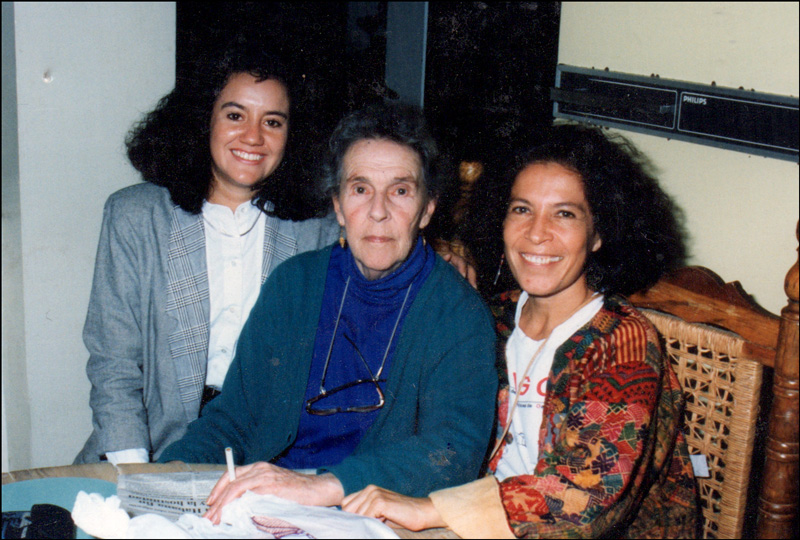Leonora Carrington: Rebellion, a defining feature
Why not grant the most humble objects cosmic powers? Why not create a universe of priestesses and ghosts? Why not try to uncover a complex side of the world, to save us from traps?
Rebellious and immune to simplification, Leonora Carrington (1917) has always asked these questions. Without producing clear answers, the English painter recreates them repeatedly in paintings, sculptures and etchings. “For me, color, matter and cloth have become my connection with the world. Beyond a language, painting is a way of life.”

Angélica Abelleyra, Leonora Carrington y Lucero González. Photo: Emerico "Chiki" Weisz, febrero de 1995.
On April 6 1917, an Irish country girl and a rich English businessman had a daughter who would turn out to be in-ed-u-ca-ble. This was the verdict of two tutors in Clayton Green in Lancashire, England, and the headmistresses of two Catholic boarding schools in Chelmsford and Ascot, where the young rebel was only interested in drawing, inspired by the Irish popular tales told by her nanny.
When she was an adolescent, Carrington’s parents sent her to Florence and Paris, to train her in the practices of English aristocratic society. This was so far removed from her spirit that in 1936, interested in alchemy and occultism, she joined the academy of the purist painter Amédée Ozenfant in London.
In England, she rapidly identified with the surrealist community and embarked on a relationship with the painter Max Ernst, with whom she fled to Paris in the late 1930s. Settled in the south of France, carrying out joint work projects such as the sets for Alfred Jarry’s play King Ubu, she also continued to create dream-inspired universes in paintings and the short stories collected in The Oval Lady, published in 1939 with illustrations by Ernst. He was imprisoned by the Nazi party that year, and Carrington fled to Spain when she was unable to secure his release. In Santander, she suffered an episode of delirium, and after a nervous breakdown was admitted to a psychiatric clinic for six months at her family’s request.
In 1941, Carrington’s father asked for her to be transferred to South Africa, but she went to Lisbon instead, taking refuge in the Mexican Embassy. There she met the writer Renato Luc, who agreed to marry her so that she could obtain a visa for Mexico. The couple lived in New York before moving to Mexico in 1942 to join the artistic community there.
Among the work that Carrington produced in Mexico are the play Penelope (1946), produced by Alejandro Jodorowsky in 1962; The Stone Door (1976) and The Stolen Pigeon (1986). However, the books The Seventh Horse and The House of Fear express Carrington’s thoughts, dreams and nightmares most effectively.
Hundreds of drawings, watercolors, temperas, sculptures, tapestries and the mural The Magical World of the Mayas (1963, on display at the National Anthropology Museum in Mexico City) provide an insight into her universe, which relied more on concepts than feelings. Her painting is undecipherable, rejecting the conventions of femininity, beauty and skill in favor of Celtic myths, Kabbalah, Buddhism and Gnosticism, a tribute to her frenzied journey through a world in constant metamorphosis.
A text originally published in La Jornada Semanal (September 22, 1993), part of a book edited by the Autonomous University of Nuevo Leon.